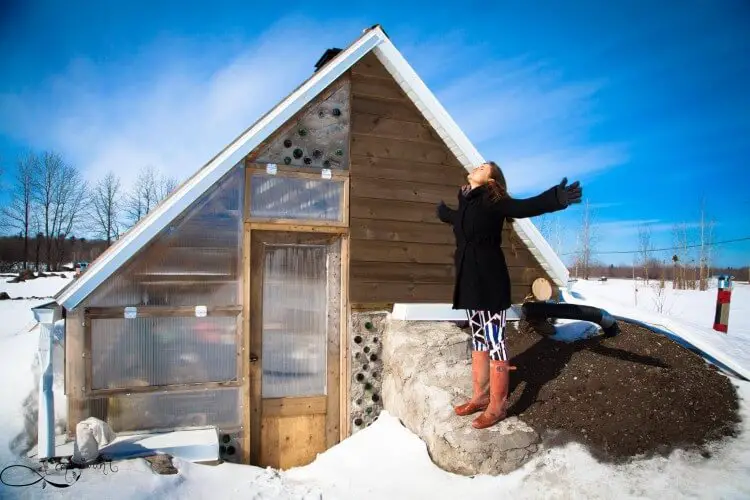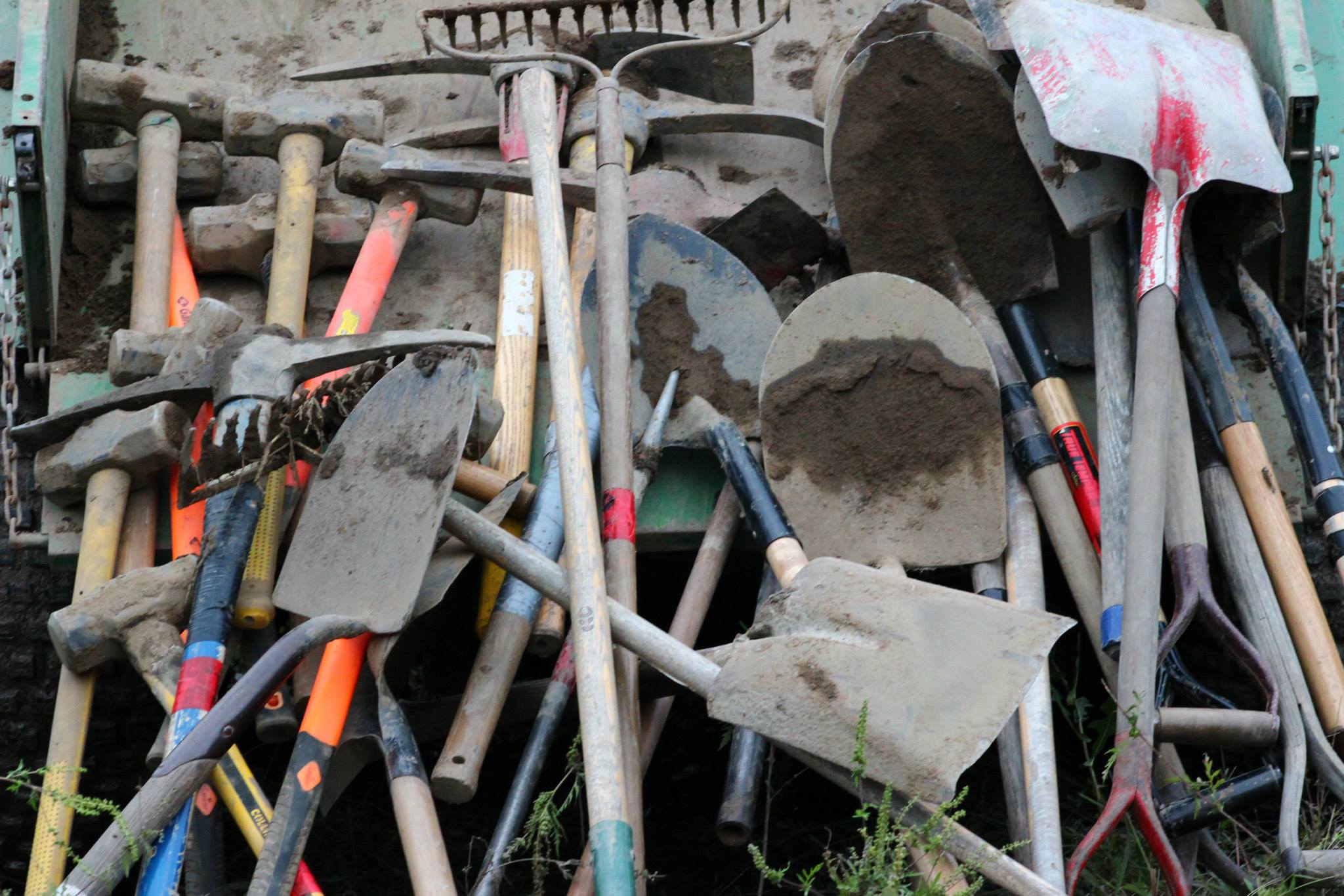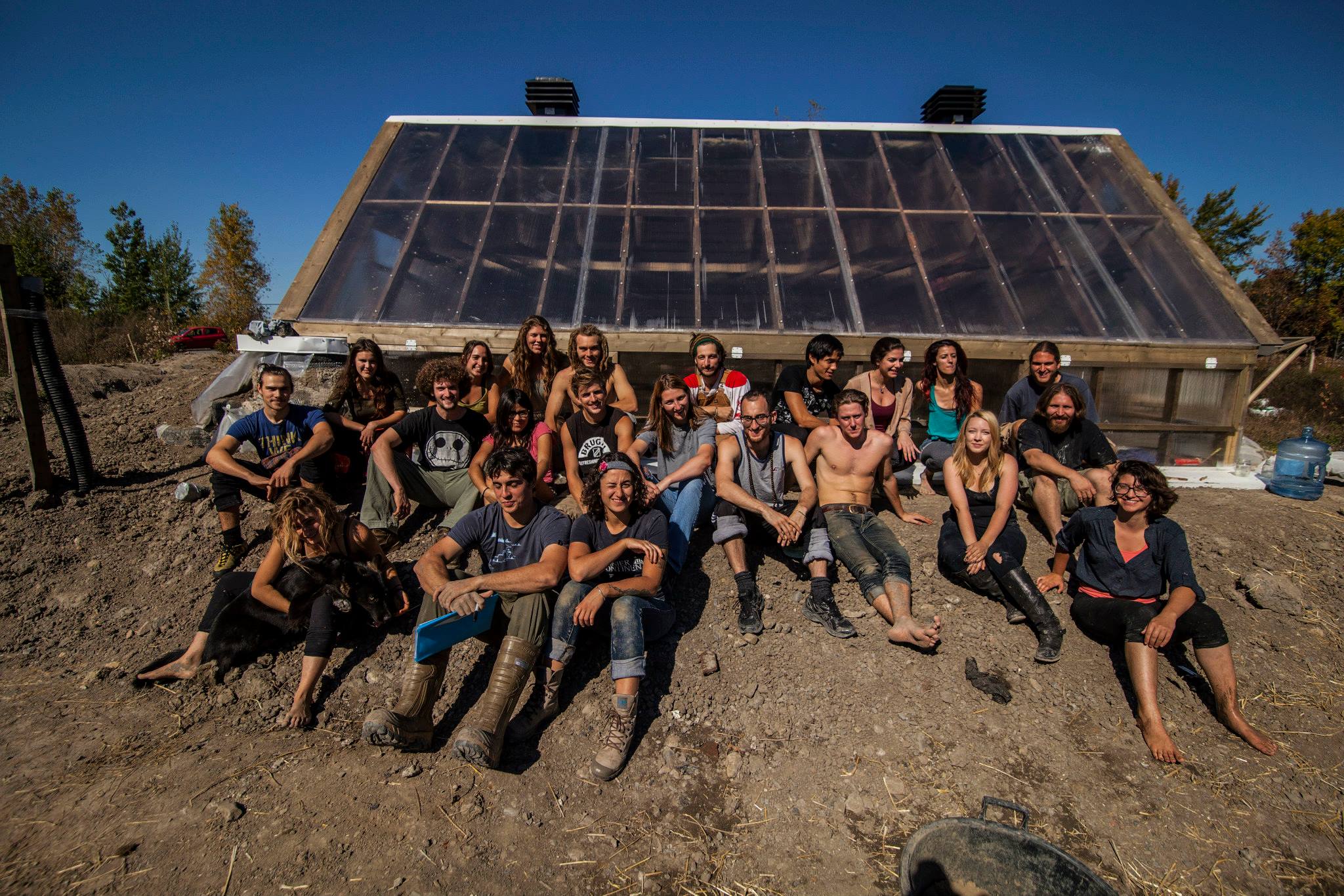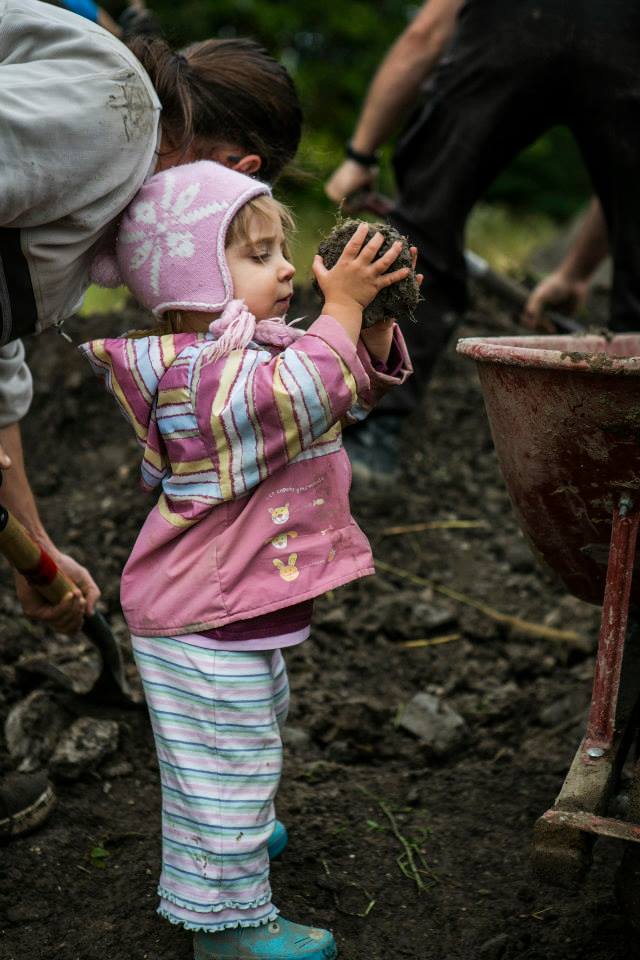Not long ago on our land at the Valhalla Movement we spent three months building our Earthship-inspired greenhouse. It was messy, unnecessarily long, cold, and fraught with unpredictable challenges. We thought that the integrity of our mission plus the enthusiasm of our team and our supporters would be enough to get the local municipality on our side. We thought that our plans would be approved in no time. We were wrong. If we had done sufficient research beforehand, we wouldn’t have made such casual assumptions. The biggest mistake that we made was assuming, in doing so we did not plan the build thoroughly or timely.
There’s a lot to cover, so let’s get to it!
Also we did build a DVD guide and ebook to help with the specifics the actual building of it see end for details.
1. Research the construction codes and regulations in your area
Our mistake
Due to stringent agricultural land laws, we couldn’t build a makeshift bathroom on our land or let people camp out there. Our building team ended up having to hold it in for most of the day until they got back to our house for the night.
The lesson
It is absolutely CRUCIAL to understand what your team needs. Do they need a toilet on the land itself? A spot for camping and making fires? How many meals a day will you be providing? If you are also facing land limitations, then make sure you have a back-up plan. Being able to go to the bathroom during a long hard day of work is not to be taken lightly!
Residential and commercial building codes are very complex in the United States and Canada, so do plenty of research and make sure that your dream Earthship complies with both federal and state/provincial laws! Alternatively you can hire a lawyer, but you can definitely find out yourself if you put in the time and patience. Building codes are often taken care of by municipalities themselves – keep that in mind.
Make sure you know:
- What kind of zoning is my land considered? What building restrictions are there for that kind of zoning?
- Do I need a building permit from my local municipality or province/state?
- How do construction inspections take place?
- Am I allowed to use car tires as part of my foundation?
- Do we need to build a toilet and set up a temporary living space on the construction site? If so, are there any local or federal regulations about it?
Canada:
The National Building Code of Canada (http://www.nationalcodes.nrc.gc.ca/eng/index.html) is a model building code – that means it has no legality until it is adopted by provincial regulations. Most provinces have their own versions of the building code, so research the appropriate documents for your province.
- Alberta committed in 2007 to using the National Building Code as its standard, but it also made a few changes to suit Alberta’s needs. The regulations are administered by Alberta Municipal Affairs.
- Ontario’s building codes and regulations are administered by the Building and Development Branch of the Ministry of Municipal Affairs and Housing. Note that much of the decision-making roles are given to local municipalities, so make sure you look into that!
- Vancouver is the ONLY city that has its own building code that is separate from the provincial and federal models.
- Quebec’s construction codes are overlooked by the Régie du bâtiment du Québec. Make sure that you look at both the Construction Code (intended for architects, engineers, and planners) and the Safety Code (intended for the owners of buildings, equipments, and facilities).
- Prince Edward Island, Nova Scotia, Manitoba, Saskatchewan, and Newfoundland/Labrador have all adopted the National Building Code.
The United States:
The U.S. has several model building codes that are maintained by the International Code Council (ICC).
- International Building Code (IBC) – applies to almost all types of new buildings.
- International Residential Building Code (IRC) – applies to new one and two family dwellings and townhouses.
- International Existing Building Code (IEBC) – applies to the alteration, repair, addition, or change in occupancy of existing structures.
Although most states and local governments have adopted these codes, make sure you know exactly which regulations your state and town follow!
2. Get your plans stamped and looked over by a licensed architect and engineer
Some background
In 1990 a repository of 3.5 million car tires had burned in St. Amble, which released dark plumes of thick and noxious gas that are an environmental risk both to the air and water supply. Thus all car tires are considered a fire hazard in Quebec and can not be used in construction without an affidavit of safety guarantee. No exceptions.
Our mistake
We thought that the local municipality would okay the use of car tires in our Earthship greenhouse because of the research and solid convictions held by Earthship Biotecture about the viability of car tires. Since Earthship tires are pounded with dirt and covered with cement, there would be no air to consume even if the rubber caught on fire. Unfortunately, we had neither an engineering or architectural stamp on our plans when we submitted them in May. The result? Rejection.
Our solution
After we were rejected, we frantically searched for an architectural firm that would stamp our plans. However, none of the firms would stamp our pre-made plans! They either asked for $5000+ or demanded that we pay them to completely redesign the greenhouse structure. We were baffled. We did not have that kind of money nor did we want to compromise the integrity of our Earthship-greenhouse, so we kept looking. Finally a prominent eco-architecture firm, L’Oeuf, helped revise and stamp our plans to comply with regulation standards. The fee was extremely reasonable and they also kept the structural integrity of our original plan intact. BONUS: WE ARE GIVING AWAY ARCHITECT PLANS FOR FREE – Just need to sign up for newsletter at Valhalla Movement.
The lesson
Our Earthship greenhouse was originally designed by Francis Gendron, who had attended Earthship Academy and has experience building sustainable structures, but he is not a professional architect. Oftentimes you can design your own plans if you are constructing small structures. For larger ones, approved professional plans are necessary. Know exactly what your plans need in order to be approved by the local government!
Make sure you know:
- Will I be able to design the structure myself?
- If so, does it have to be under a certain size? What are the state rules regarding this?
- How much will it cost for a professional architect and engineer to design my structure?
- How much will it cost to get a stamp of approval on designs I’ve received from elsewhere (such as from Earthship Biotecture)?
3. Budget your funds properly
What we did well
We launched a Kickstarter campaign in April to raise $10,000 for our Earthship-inspired greenhouse. We ended up getting $28,000! It was an incredibly memorable day and we are extremely grateful to our donors.
Our mistake
Despite receiving more funding than we anticipated, our budget was not organized well enough. Resources were not accounted for, some were estimated at lower costs, and some weren’t even in the budget to begin with. This caused materials to be acquired in less then ideal ways, for the sake of time and convenience. There were also numerous incidences where people paid for construction materials out of their own pocket because there just wasn’t enough money in the budget. When a budget is well-organized, that should NOT happen!
Our solution
In the end, we pulled through thanks to additional donations from our supporters and ingenious recycling of materials. We also got a lot of resources for free, such as glass bottles and metal cans. Some of our members still paid for some of the costs themselves, but we reimbursed as many people as our finances would allow.
The lesson
It is absolutely crucial to plan your budget well in advance of the build, preferably as soon as you know exactly how much you have to spend on the entire project. Leave ample padding for any discrepancies or miscellaneous expenses. It will be helpful to assign one or two people to this task so as to streamline the process. The person(s) who mock up the budget should get quotes from different materials manufacturers and construction companies. Having plenty of time to make these calls will ensure that you are able to secure the best deals. Make sure that you understand the needs and specifications of your structure when you make those calls!
Additionally…
The budget leader(s) must consult the rest of the team. The budget has to be agreed upon or else there will be avoidable disagreements and confusion along the way. If some people think that Category A should be allotted more (or less) money than the materials in Category B, the budgeter should take such input into serious consideration. The group should come to an overall agreement through consensus decision-making or whatever process is appropriate for the team.
Make sure you know:
- What are the best industry prices for what I need?
- Are there any adjustments that need to be made after I’ve talked to the team?
- Have I accounted for miscellaneous expenses?
- Is there anything in my budget that may require more money than I can currently allocate to it?
4. Know exactly what resources and tools you will need, when you’ll need them, and where to get them
Our mistake
The Valhalla land is not hooked up to the grid so we have no access to electrical lines or water pipes. We had to use a generator, which we had not accounted for in our budget and planning. Our one and only solar panel could not generate the amount of electricity we needed to power drills, tractors, cement mixers, and other high-powered tools. Additionally, with no running water, we had to haul water (for drinking and for washing) to the land manually by filling five to six 5-gallon bottles with tap water from our faucets. It was not an efficient process.
The lesson
Know what capacities you currently have and make a list of what you’ll need to acquire in time for the build!
Make sure you know:
- What tools do we need?
- What kinds of structures can we pre-assemble before the actual build?
- Do we have all the materials and resources ready?
- How many people do we need on the build each day?
- Is there ample electricity and running water on the land?
- Will we need a generator? A cement mixer? A tractor?
5. Delineate individual roles and teams with assigned leaders to manage each aspect of the build
What we did well
During our build, roles were filled based on people’s various expertise, skill sets, and interests. This came about organically as we started construction, but it helps to set up roles ahead of time.
The lesson
A successful building project requires efficient leadership on all levels. There should be one person who takes charge of such tasks. The stress and pressure during construction can be very hectic and difficult to manage if people are unsure of who to look towards for guidance and action steps. Keep in mind that a team leader is not someone who simply dishes out instructions but someone who can harmonize the skills and strengths of the individuals on the team. Each member decides what he/she is going to do for the build; the team leader then organizes all the tasks/responsibilities and keeps track of timing.
Our task forces:
- Construction
- Food and water
- Volunteer/worker organization and morale (essentially HR)
- Media (photography, videography, blog posts)
- Finances and budgeting
- Off-site errands
6. Know how much food you will need to provide
Ingredients are often quite expensive, especially for large teams, so try to get the things you need from supportive friends, family, and even neighbors. Maybe even pick the fruits, vegetables, and herbs yourself if you have a garden.
What we did well
We were able to prepare cheap meals en masse using ingredients such as beans, rice, tomato sauce, pasta, homemade flatbread, and sweet potatoes. We also used fresh tomatoes, peppers, squash, herbs, carrots, and some fruits from our own garden. Another good way to cut down costs is dumpster diving. We went dumpster diving at organic food supermarkets for some of our pre-packaged or bagged ingredients, which saved us a lot of money too. Supermarkets tend to throw out their produce JUST as they are fully ripe but not yet rotten. There is a wealth of great information and tips online about safe and lawful dumpster diving, so do some digging!
Our mistake
We underestimated how hungry people would be. On a few days, we didn’t make enough food for everybody to get seconds. Fortunately the construction crew were very forgiving and some had even brought their own snacks to munch on. Still, it didn’t feel good to not be able to provide. Construction is hard work, and we really believe that the builders deserve nothing less than a feast fit for a king! Our kitchen crew was also short-staffed so the people cooking were more stressed out than we had anticipated.
The lesson
If you are organizing a large build spanning many days, it is crucial to organize a good kitchen crew with enough ingredients and tools to prepare the amount of food needed for that many people. Making food for yourself and your family is very different than cooking for 30-50 people! Preparations and cooking take the whole day, and it DOES get tiring, so it is very helpful to rotate the crew throughout the various meal times. There will be room for improvisation and experimentation, but for the most part the head chef will plan the menu and make sure that all the ingredients are ready for the day.
Lastly, do not underestimate how much food your team will need. It is always better to make too much than too little. Meals are precious times for relaxation, connecting, and refueling – make them memorable and fulfilling!
Make sure you know:
- How many task forces do we need, and who will take responsibility for each one?
What other experts and people do we need? - How much food will the kitchen crew need to prepare each day?
- How are we going to get all the ingredients? Are we asking for donations or dumpster diving?
7. Celebrate and congratulate one another during the build and after major milestones!
The lesson
Construction is very hard work, but that’s not all it should be! It can be an enriching bonding experience when volunteers, members, workers alike share stories, personal notes, and jokes with each other. We found that time passed by much quicker and work was more enjoyable during conversations and moments of resounding laughter.
Every individual is incredibly interesting and has a story to tell or something you can learn from. It’s up to you to be curious and engaging in order to dig beneath the surface and find the treasure waiting beneath.
When you accomplish a major goal or reach a new point in your building construction, take some time out to celebrate! Make a little something special for dessert, go for a round of nice cold beer, throw each other into the pond/lake/river/pool… It’s these moments that remind you what you are all working towards and how well you are working together to make it happen.
Remember – work hard AND play hard.
8. Don’t hesitate to ask for and accept help!
Recognize where you and your team’s strengths and weaknesses lie so that you have a good idea of what you need help with.
What we did well
We were lucky enough to have an extremely talented core group of workers with a diverse range of talents. Each person was an experienced builder and many also had the practical skills needed to carry out specific and extremely important tasks. When necessary, though, we were not afraid to ask for help. We did a massive call-out and organized two successful volunteer weekends where 50 people came to learn and help out with the build! It was incredible to see that kind of support come out. All it took was a genuine humility and some reaching out.
We got a lot of stuff for free, such as bottles and cans, thanks to our friends, family, supporters, and community! When trying to get recycled materials such as car tires, glass bottles, and cans, ask around your community/neighborhood! You can also find car tires in your local junkyard or scrap yard. There are different sizes you’ll need so know which ones are right for your plan.
You WILL need help, sometimes from people you don’t know and for things you didn’t expect. Don’t doubt that people genuinely want to lend a hand, often without any compensation or service in return. Be grateful for their support and genuinely thank them for their kindness. You may not need to “repay” them, but a token of your gratitude is always be welcome and meaningful.
Ask yourself:
- What are your team’s strengths? Weaknesses?
- Do you need a carpenter, an irrigations system expert, an electrician, a videographer/media specialist?
- Are there certain resources that you and your team can’t get yourselves?
- What tasks and jobs require a specific skill set?
- What can you can offer or exchange for someone’s help?
In conclusion…
There are many factors that will play into whether or not your build is successful; effective and timely planning is only one (albeit crucial) part of it. There will be factors that are out of your control, such as how long the local municipality takes to approve your build, the weather, and individuals’ dispositions. It does not serve you to worry about such factors. The only things you can do is know when to let go of your frustration and to channel your energy towards figuring out how to work around unforeseen problems that may arise.
Your building process, organizational structure, and ways of tackling problems will inevitably be very different from ours. We are here to share our experience so that you can avoid the mistakes that we made. We are here to help and to listen to your stories so that we can also learn from YOU.
Please comment below with any comments, questions, concerns, corrections, inspiring anecdotes, or stories you have. We want to connect more with all of you who are taking concrete steps towards making your lifestyle more ecologically conscious and responsible.
Checklist:
- A detailed budget
- Research on building codes and land regulations
- Approved plans
- List of all the necessary material resources and information about where to get them
- Estimate on how many people will be needed on the build
- A schedule/calendar of the build (including details about the tools/resources/people needed on each day)
- Food menu
- Call-out for help from friends, family, members of your community, and your greater network
- List of task forces, members in each force, and assigned leaders
- Ideas for playing games, bonding exercises, and festivities
- A positive energy and proactive attitude, even amidst potential failure and obstacles
Good luck, and have fun building!











